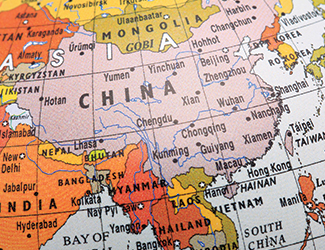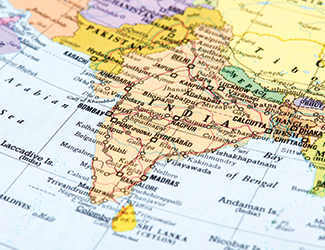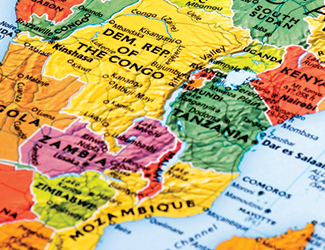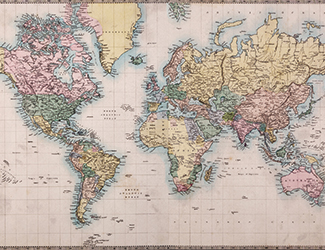A Brief History
Discover the ancient origins and fascinating history of tea!
No doubt you have your own favourite tea brand or blend, but do look through this section and discover other wonderful teas to go out and try...
Although tea was discovered in China nearly five thousand years ago, it took several thousand years before the plant, botanical name Camellia sinensis, found its way to other parts of the world.
Today, tea is grown on a commercial scale in approximately three dozen countries and, in each country, the product makes a significant contribution to the economy of the agricultural sector.
Tea is grown from China to Argentina, Nepal to South Africa, and, next to water, tea is the worlds most consumed drink.
Tea scientists have been working closely with nature for the past two hundred years to produce new tea cultivars that can thrive in difficult conditions like drought yet continue to produce satisfactory yields that deliver the quality that consumers expect.
There are approximately 1,500 different varieties of tea, all offering interesting and varied style's, taste and colour. The character of tea, like wine, is influenced by the elevation of the garden, the soil, wind conditions and temperature and, of course, the quality of the plucking. With so many teas to choose from there is a lifetime of enjoyable exploration ahead.

Known as the birthplace of tea, for hundreds of years China produced the only teas known to the western world. Although consuming much of her own production, China still accounts for over 18.5% of world exports. China has 2,649,840 hectares planted with tea.
As well as black teas, China produces five other principal types for which the country is famous: Green, Oolong, White, Flavoured and Compressed teas. With some exceptions - such as Lapsang Souchong, Gunpowder and Keemun - most teas from China are not easily found in the general marketplace.
Lapsang Souchong Keemun Yunnan
Many green China teas are still traditionally made by hand using methods that have been handed down from generation to generation. However, more and more teas are now made in mechanised factories. Green teas are totally unoxidised (compared to black teas which are fully oxidised) and so the first stage of the manufacturing process is to kill any enzymes that would otherwise cause oxidation to take place. To de-enzyme them, the freshly plucked leaves are either steamed (to make 'sencha-type teas) or tumbled quickly in a wok or panning machine (to make pan-fired teas) and are then rolled by hand or machine to give the leaf a particular appearance - some teas are twisted, some curved, some rolled into pellets, etc. To remove all but 2-3% of the remaining water, the tea is then dried in hot ovens or over charcoal stoves.
Gunpowder Chun Mee Oolong Tie Kuan Yin Pouchong
White teas traditionally come from China's Fujian province and are made from leaf buds and leaves of the Da Bai (Big White) tea varietal by the simplest process of all teas. Very young new leaf buds and baby leaves are simply gathered and dried - often in the sun. The manufacturing process includes no withering, no steaming, no rolling, no oxidising and no shaping. The best known white teas are Pai Mu Tan (White Peony) which is made using new leaf buds and a few very young leaves, and Yin Zhen (Silver Needles) which is made from just the new leaf buds.
The official Chinese definition for Puerh tea is "Products fermented from green tea of big leaves picked within Yunnan province". However, even Chinese specialists cannot agree on the true definition but, in general terms, Puerh teas are teas from Yunnan that are aged for up to 50 years in humidity- and temperature-controlled conditions to produce teas that have a typically earthy, mature, smooth flavour and aroma.
There are two types of Puerh tea made by two different methods of manufacture: Naturally Fermented Puerh tea (also known as Raw Tea or Sheng Tea) and Artificially Fermented Puerh tea (also known as Ripe Tea or Shou Tea).
To make Naturally Fermented Puerh tea, fresh leaves from the bush are withered, de-enzymed in a large wok, twisted and rolled by hand, dried in the sun, steamed to soften them and then left loose or compressed into flat cakes or blocks of various shapes. The tea is then stored in controlled conditions to age and acquire its typically earthy character.
To make Artificially Fermented Puerh tea, fresh tea leaves are withered, de-enzymed in a large wok, twisted and rolled by hand, dried in the sun and then mixed with a fixed quantity of water, piled, covered with large 'blankets' made from hide and left to ferment. The tea is stirred at intervals and the whole process takes several weeks. When the teas have fermented to a suitable level, they are steamed and then left loose or compressed in the same way as Naturally Fermented Puerh teas.
The teas are then stored in damp, cool conditions to age. Naturally Fermented Puerh teas are left for at least 15 and up to 50 years; Artificially Fermented Puerh teas are aged for only a few weeks or months. When ready, each cake of Puerh tea is wrapped in tissue paper or dried bamboo leaves.
The reason for manufacturing Puerh teas by artificial fermentation is to allow the tea producers to make more Puerh in a shorter time. 50 years is a long time to wait for a good Puerh so the more modern artificial method was developed to meet a growing demand for these teas.
Puerh tea is named after Puerh city in Yunnan province which was once the main trading centre for teas made in the area.
Jasmine Rose Congou Earl Grey More Flavoured and Scented Teas

India is one of the main tea growers, exporting more than 12% of the world's tea and with 566,660 hectares under cultivation. Although indigenous to the Assam region, the first commercially produced teas were raised from seeds brought from China.
By the 1840s, India was producing regular shipments for sale at auction in London, and gradually the planting of estates grew throughout the country from Nilgiri in the south to Darjeeling in the north.
The plantations range from low-grown areas (sea level up to 2000ft) to high-grown (more than 4000 ft high). Generally plucked from March to October, each area produces teas of distinctive character. The Tea Board of India has endorsed several speciality blends so that their quality and consistency is assured.
Although India produces mostly black teas, a small amount of green tea (1% of total production) is produced mainly for the Afghanistan market.
Assam Darjeeling Nilgiri India Tea
Sri Lanka has 187,935 hectares under tea cultivation yielding 328,961 tonnes of "made" tea, and accounting for over 17% of world exports. In 1972, the island then known as Ceylon reverted to the traditional name of Sri Lanka, but retained the name of Ceylon for the marketing of teas.
Tea from Sri Lanka falls into three categories: low-grown (on estates up to 2000 ft high); medium grown (between 2000 and 4000 ft); and high grown (over 4000 ft). Each level produces teas of unique character. By blending teas from different areas of the island, Sri Lanka can offer a very wide range of flavour and colour. Some are full-bodied, others light and delicate, but all Ceylon blends will have brisk full flavours and bright golden colour.
Because of the geographical location, tea can be plucked in Sri Lanka all year round: the west and east of the island are divided by central mountains so that as each region's season ends, the other begins.
Dimbula Kenilworth Uva Saint James Nuwara Eliya Nuwara Eliya Estate Ceylon Blend

One of the oldest of the African producers, Kenya has a history of tea dating back to 1903, when tea seeds from India were first planted on a two acre farm. Today, Kenya has 203,006 hectares under cultivation by smallholders (shambas), under the protection of the Kenya Tea Development Authority, and tea producing companies in the public and private sector. Kenya exports over 443,461 tonnes of tea per year (25% of world exports). Kenya's equatorial climate allows tea growing all year round.
The teas are very bright, colourful, with a reddish coppery tint and a pleasant brisk flavour. Kenya speciality tea is ideal as a drink for any time of day or night and is particularly ideal with beef and horseraddish or ham sandwiches and rich chocolate cake. In the after dinner slot Kenya tea will enhance the flavour of a smoked cheese taken with Drambuie. Kenya teas are also blended into many famous British brands.
Malawi is the pioneer of tea growing in Africa, with production first starting commercially in the 1880s in Mulanje. Now exporting some 31,000 tonnes annually, Malawi has a 1.7% share of world exports and is mainly responsible for the spread of tea cultivation in Africa. Malawi was the first African country to adopt the cloning method of estate refurbishment. Although Malawi teas are not so well known as speciality teas, their superb colour and brightness means they are used in the blending of leading British tea brands.
Tea production in Zimbabwe could begin commercially only after the successful establishment of irrigated tea estates. With an average annual rainfall of not more than 26 inches per annum, as opposed to the 50 plus inches per annum usually required, irrigation is essential to continuous growth. Zimbabwe now exports over 11,000 tonnes of tea per year from 5,500 hectares. Today, tea is a "controlled" commodity in Zimbabwe so that its quality and industry growth are protected.

Tea production in Tanzania is thought to be the legacy of German colonisation under the reign of Kaiser Wilhelm II, but its real development took place under British estate ownership between the two World Wars. Tanzania now exports over 27,500 tonnes of tea annually.
These different altitudes result in distinct tea characteristics, but all Tanzanian teas are bright in colour with a brisk flavour that makes them ideal for use in blending.
A black cut, torn and curled tea (link to the CTC explanation) the tea factory andblack tea manufacture from KwaZulu is the only South African tea to be exported for international consumption.
The flavour is strong and lively and is best drunk with milk.
Tea has been part of the way of life in Indonesia for more than 200 years. Situated in the South China Sea and the Pacific Ocean, Indonesia forms an island chain stretching from Malaysia to Papua New Guinea. Java and Sumatra, two of the largest islands, are the main growing areas.
After the World War II, the Indonesian tea estates were in very poor condition. Wrecked factories and tea bushes that had reverted to their wild state were just two of the problems which faced the country.
By 1984, after a lot of hard work and investment, tea exports from Indonesia began to make their mark on thetea market. Since that time, improvement in tea production and replanting of old estates has continued, with the factories investing in new machinery. Now, Indonesia had some 121,000 hectares under tea cultivation, with 65,000 of these being on Java. In 2015, Indonesia exported over 65,000 tonnes of tea, accounting for 3.6% of world exports.
Teas from Indonesia are light and flavoursome. Most are sold for blending purposes as this produces good financial rewards through foreign exchange for the country. In recent years, however, it has become possible to buy Indonesian tea as a speciality. It is extremely refreshing taken without milk: garnished with lemon, it makes an ideal drink for the figure-conscious.
The Japanese have always been known to produce high quality green tea. The worldwide export of Japanese tea has dwindled over the past few decades, almost entirely due to price considerations, land and labour costs in Japan are comparatively more expensive than other tea growing regions in the world. Japan has 4,800 hectares planted with tea.
These are blends that can come from more than one country or region and popular on the UK speciality tea market. You may be the kind of person who blends their own tea or has had an unusual tea somewhere in the world, if you are we want to hear from you, click here to tell us about it.
English Breakfast Afternoon Tea House Blend Flavoured Teas Bubble Tea Chai Iced Tea